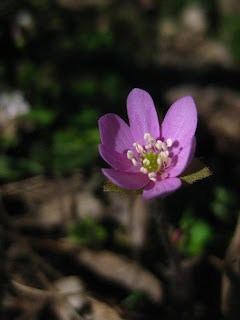This is quite possibly the most beautiful place on earth...
The sea of white above is thousands of Fringed Phacelia, Phacelia fimbriata, blossoms like these. This flower is usually white, but every so often I find a purple bloom.
Sharp-lobed Hepatica, Hepatica nobilis var. acuta, is another early spring wildflower that is usually white. It also comes in shades of lavender, ranging from magenta to blue.
Canada Violet, Viola canadensis.
Blue Cohosh, Caulophyllum thalictroides. "Blue" refers to the bluish color of the leaves, not the modest yellow-brown flower.
White Trillium, Trillium grandiflorum. Have you ever seen this much Trillium? Truly amazing!
Sweet White Trillium, Trillium simile, with a visitor.
White Trillium, Trillium grandiflorum.
Dwarf Ginseng, Panax trifolius.
Wild Ginger, Asarum canadense. This is one of the coolest wildflowers I have seen in a long time!
How funky is this flower?! This is the first time I have ever seen Wild Ginger. It is definitely one of my favorites!
I saw a total of 21 species when visited the Cove Hardwood Nature Trail on Thursday, March 22nd. Other species I saw that are not pictured include:
Yellow Trillium, Trillium luteum
Common Blue Violet, Viola sororia
Early Yellow Violet, Viola rotundifolia
Foamflower, Tiarella cordifolia
Rue Anemone, Thalictrum thalictroides
Halberd-leaved Violet, Viola hastata
Star Chickweed, Stellaria pubera
Spring Beauty, Claytonia caroliniana
Trout Lily, Erythronium umbilicatum
Bishop's Cap, Mitella diphylla
Wood Anemone, Anemone quinquefolia
Squirrel Corn, Dicentra canadensis
Dutchman's Breeches, Dicentra cucullaria
Cut-leaved Toothwort, Cardamine concatenata
Yellow Mandarin, Disporum lanuginosum











































